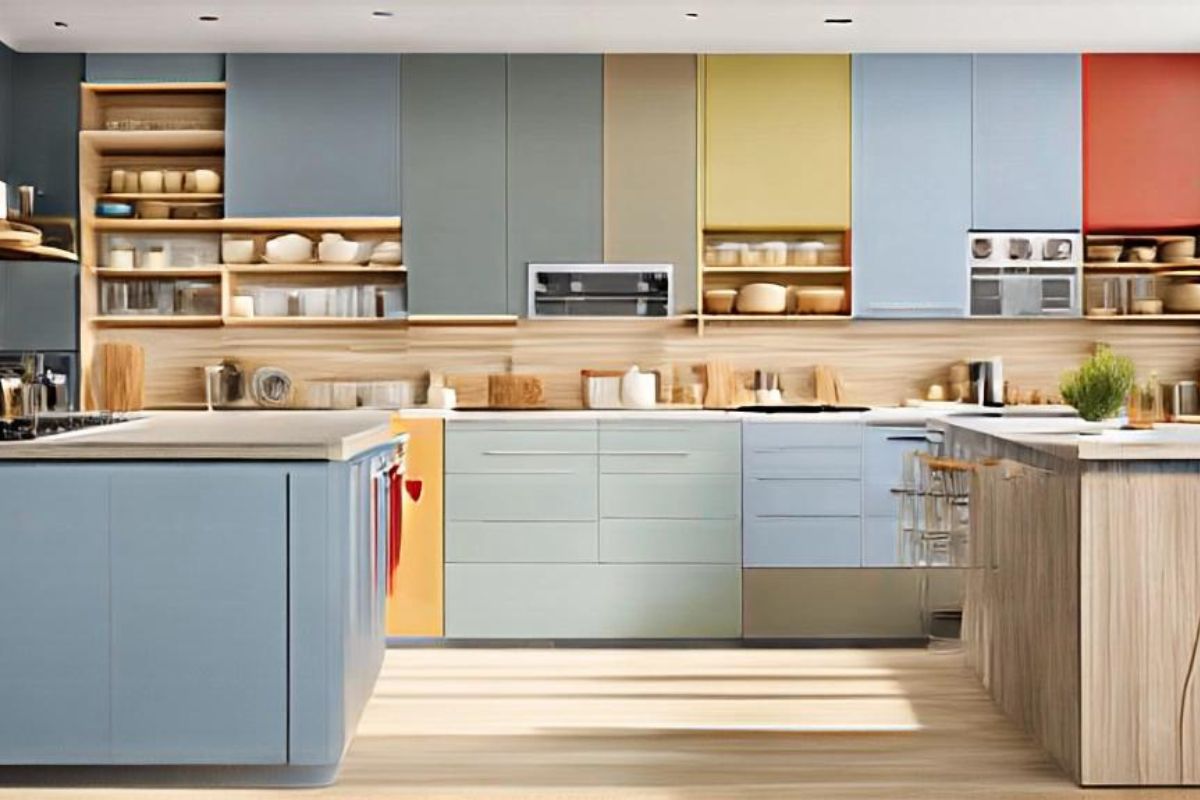Maybe you're intrigued by the energy that deep teal or ruby red can bring to a modern kitchen. The complexity of choosing the right palette is a captivating journey, and grasping the prevailing trends in kitchen design might just spark your next renovation project.
Understanding the Color Psychology in Kitchens
To truly excel in kitchen design, you need to explore the captivating world of color psychology, understanding how different hues can influence our mood, emotions, and even appetite.
Warm colors like red, orange, and yellow are known to stimulate appetite and evoke feelings of warmth and happiness. It's no surprise then that these colors are often seen in food packaging and restaurant logos.
On the other hand, cool colors like blue, green, and purple tend to suppress appetite and create a calming, relaxing atmosphere. These colors are ideal for creating a serene, tranquil kitchen environment where you can unwind and de-stress after a long day.
Neutral colors, such as white, gray, and brown, are versatile and enduring. They can create a minimalist, clean, and organized kitchen space, or they can serve as a balanced backdrop for bold, dynamic accents.
.jpg)
Top Monochromatic Kitchen Color Schemes
Exploring the world of monochromatic kitchen color schemes, you'll find a variety of options that not only exude elegance and simplicity, but also profoundly impact the overall mood and feel of your cooking space.
Monochromatic color schemes utilize different shades, tones, and tints of a single hue for a clean, sophisticated look.
One top choice is the all-white kitchen, known for its classic charm and enduring appeal. It's versatile and can be jazzed up with metallic accents or kept minimalistic for a sleek, modern vibe.
Another popular monochrome scheme is grey. Ranging from light dove to dark charcoal, grey offers an array of tones for a chic, contemporary kitchen.
Then, there's the black kitchen, imbued with an air of sophistication and dramatic flair. It's a bold choice that can make small spaces seem larger and more defined.
Exploring Vibrant and Bold Kitchen Palettes
While monochromatic color schemes have their unique charm, don't shy away from embracing lively and bold palettes in your kitchen design. Dynamic colors aren't just for accent pieces anymore; they're becoming the stars of modern kitchens.
You might consider a deep teal or a luscious ruby red to create a kitchen that's full of life and energy.
By incorporating vivid colors into your cabinetry, backsplash, or even your appliances, you can produce a stunning visual impact. You may choose to juxtapose these dynamic hues with softer colors to balance the overall design.
For instance, pairing a bold navy blue with crisp white can result in a kitchen that's both inviting and dynamic.
The Charm of Neutral and Pastel Hues
Shifting gears from bold and lively, let's delve into the understated elegance that neutral and pastel hues bring to your kitchen's aesthetic. You'll find that these colors offer a tranquil, calming effect perfect for a space where you start and end your day.
These hues are subtle, yet effective in creating a warm, inviting atmosphere. Neutrals like white, beige, or gray, are versatile and enduring. They're safe choices, but don't mistake safe for dull. They can amplify the sense of space, making your kitchen appear larger and more airy.
Pastels, conversely, lend a soft, gentle feel. Think of powder blue or blush pink, these colors are soothing to the eye and can add a playful touch without being overpowering.
Moreover, neutrals and pastels are the ideal backdrop for highlighting your kitchen's architectural details or showcasing unique utensils and appliances. They also allow for easy updates; you can change the mood of your kitchen by just swapping out accessories or adding pops of color.
Ultimately, choosing neutral and pastel hues is about creating a serene, adaptable space that you'll love spending time in.
Influential Factors in Choosing Kitchen Colors
Even though neutral and pastel hues can create a serene, adaptable kitchen environment, several factors can influence your color choice, thereby shaping the overall appeal and functionality of your space.
Firstly, the size of your kitchen plays a significant role. Larger areas can handle bold, darker colors without feeling cramped, while smaller spaces benefit from lighter shades that reflect light and provide an illusion of spaciousness.
Your kitchen's lighting is another key factor. Natural light can make colors appear brighter, so if you've got lots of it, you can experiment with deeper hues. Alternatively, artificial light can change the color's appearance, so it's essential to test swatches under different light sources.
Your personal aesthetic is, of course, essential. If you lean towards a modern style, cool grays and whites may be your go-to, while a more rustic feel might call for warm browns and creams.
Lastly, consider the color of your kitchen appliances. They should complement, not clash with, your chosen palette. The secret is to balance your personal taste with practical considerations, ensuring your kitchen is a place of both beauty and functionality.
Conclusion
Ultimately, it's your personal aesthetic that should guide your choice in kitchen color palette. Whether you opt for soothing monochromatic schemes, lively hues, or tranquil neutral and pastel tones, keep in mind that your kitchen is a reflection of you.
It's not just about style, but also functionality. So choose a palette that not only appeals to your senses but also improves your kitchen's usability. After all, your kitchen is the heart of your home.






Share: